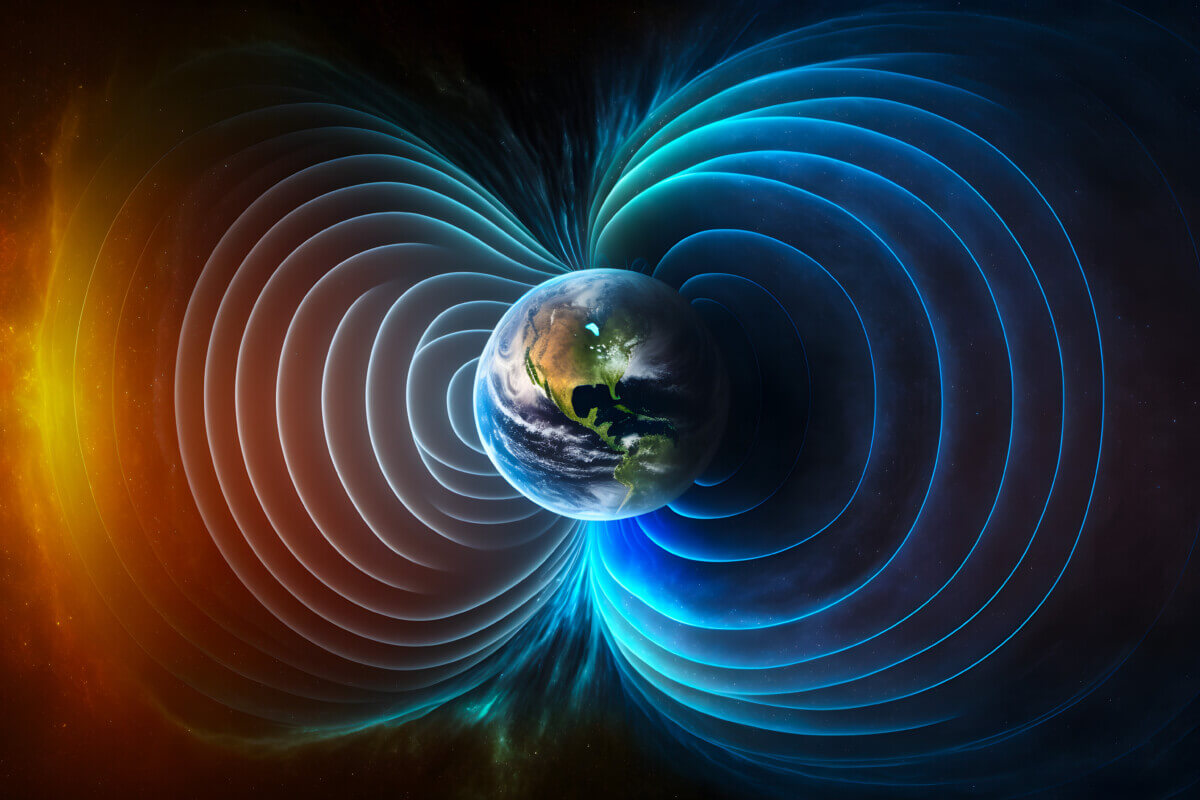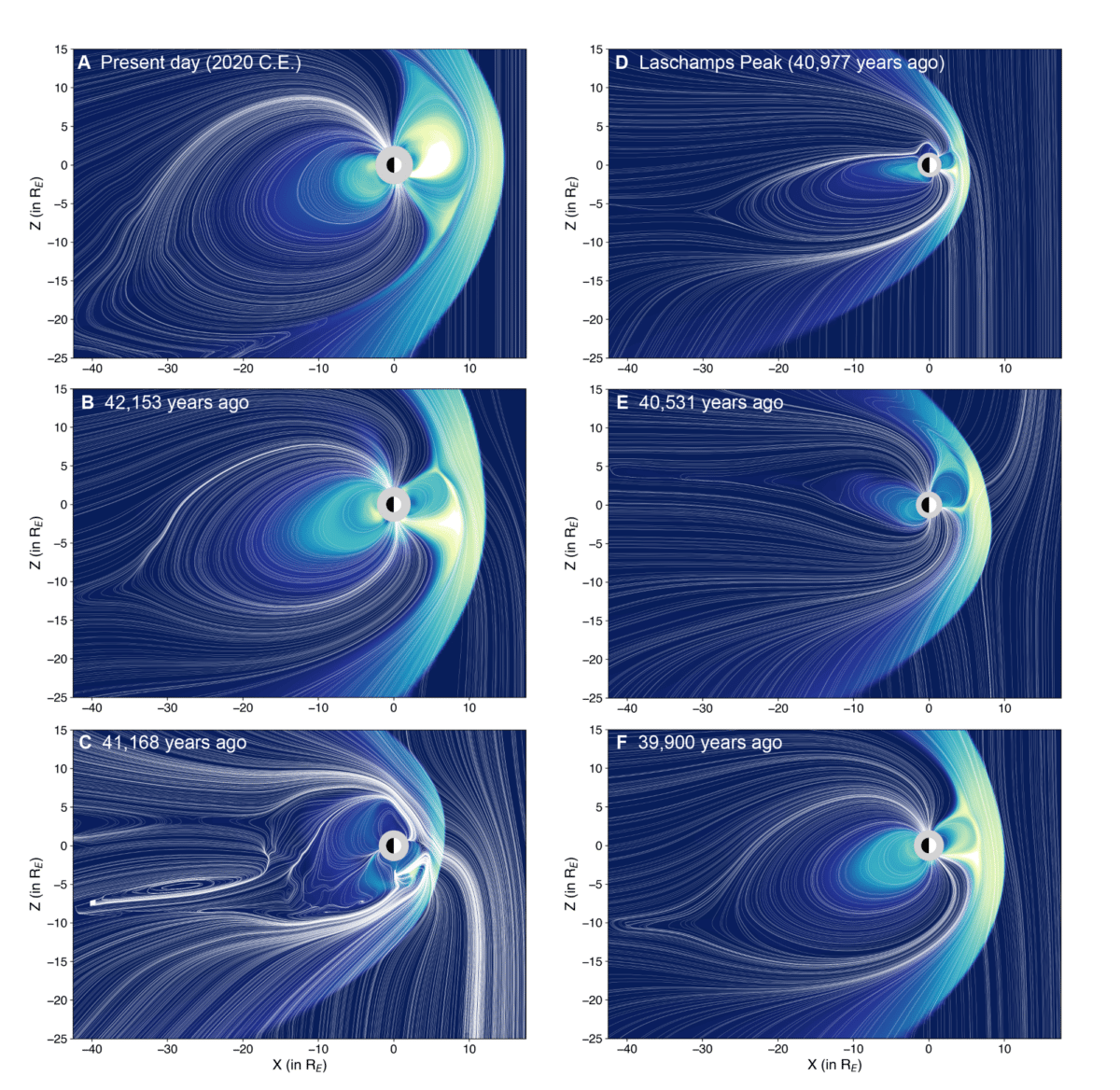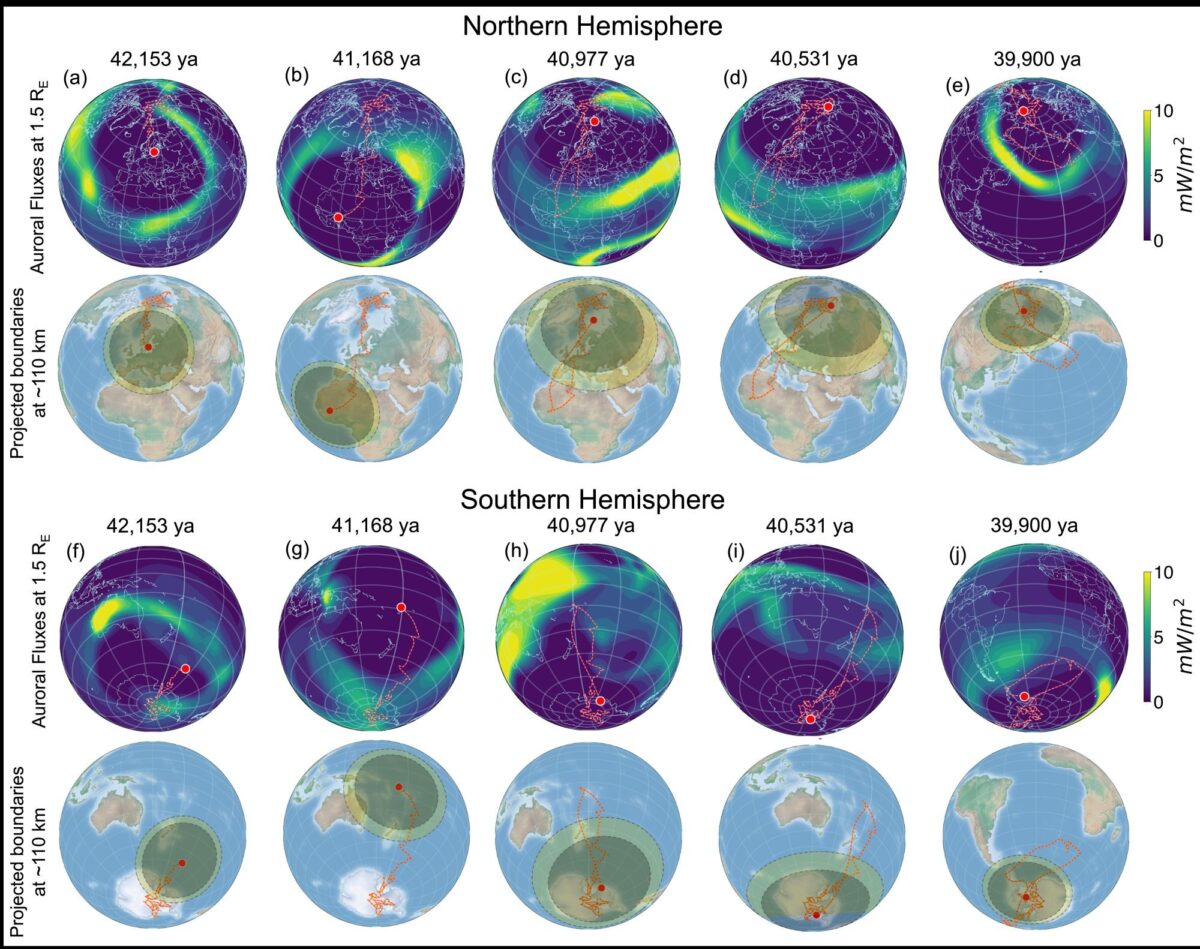
Earth's magnetic field Magnetosphere, lines of magnetic induction in outer space in orbit. Radiance in the ionosphere. (© aapsky - stock.adobe.com)
Did ancient sunscreen and sewing needles save humanity?
In a nutshell
- 41,000 years ago, Earth’s magnetic field weakened to just 10% of its current strength, causing auroras to appear globally—even over places like North Africa and Australia.
- The timing coincides with Neanderthals’ disappearance and modern humans’ development of protective technologies like tailored clothing and ochre (natural sunscreen).
- A similar event today would devastate our satellite communications, power grids, and technological infrastructure—and Earth’s magnetic field has been weakening 1% every two decades.
ANN ARBOR, Mich. — Earth’s Northern Lights typically dance near the poles, but 41,000 years ago, they lit up skies over North Africa and Australia. New research reveals how dramatically Earth’s magnetic field weakened and shifted during an event called the Laschamps geomagnetic excursion, potentially influencing human evolution at a pivotal moment in our history.
A Magnetic Field in Crisis
During the Laschamps excursion, Earth’s magnetic field weakened to just 10% of its current strength, while the magnetic poles shifted dramatically away from the geographic poles.
“The excursion lasted ~2000 years,” write the researchers, led by Agnit Mukhopadhyay of the University of Michigan, in their Science Advances paper.
Using advanced computer modeling, the research team reconstructed Earth’s magnetosphere during five key periods of the excursion. At its peak around 40,977 years ago, Earth’s protective magnetic bubble shrank dramatically – from its normal extent of 8-11 Earth radii (51,000-70,000 km) to just 2.43 Earth radii (15,498 km).
The magnetic field also transformed from a simple north-south configuration to a complex arrangement with multiple magnetic poles scattered around the planet.
“In the study, we combined all of the regions where the magnetic field would not have been connected, allowing cosmic radiation, or any kind of energetic particles from the sun, to seep all the way in to the ground,” said Mukhopadhyay.

Auroras Everywhere
These magnetic changes had astonishing effects on the auroras. The Northern Lights traveled from their usual Arctic home through Western Eurasia into Northern Africa, while in the Southern Hemisphere, auroras appeared over eastern Australia and New Zealand.
The light shows also expanded enormously in size. Modern auroral ovals typically span less than 3,000 km in diameter, but during the Laschamps event, they stretched to over 8,000 km – nearly three times larger.
At the excursion’s peak, auroras likely appeared globally, creating what researchers describe as “a near-Earth space environment unparalleled in history.”
Beyond their visual spectacle, these changes exposed Earth’s surface to higher levels of cosmic radiation and energetic particles, potentially altering the atmosphere and affecting life on the surface.

Human Evolution During Magnetic Upheaval
The Laschamps excursion coincided with a critical period in human history – as modern humans (Homo sapiens) spread throughout Europe, Neanderthals disappeared, and humans created the first known cave art.
When mapping areas affected by the wandering auroras alongside archaeological evidence, researchers found compelling correlations, particularly in Western Eurasia.
“We found that many of those regions actually match pretty closely with early human activity from 41,000 years ago, specifically an increase in the use of caves and an increase in the use of prehistoric sunscreen,” Mukhopadhyay explained.
Raven Garvey, associate professor of anthropology at the University of Michigan, notes that modern humans during this period increasingly used ochre – a mineral that works effectively as a natural sunscreen – and developed more sophisticated clothing.
“There have been some experimental tests that show it has sunscreen-like properties,” Garvey said about ochre. “Its increased production and its association primarily with anatomically modern humans (during the Laschamps) is also suggestive of people’s having used it for this purpose.”
Modern humans also invented tailored clothing during this period, with archaeological sites containing not just hide scrapers but also sewing implements like needles and awls. This clothing would have allowed for greater mobility while providing coverage and potentially protection from increased radiation.
Neanderthals appear to have lacked these technologies, possibly putting them at a disadvantage during this period of increased radiation exposure.
Modern Implications
What would a similar event mean for our technology-dependent world today? The consequences would be severe.
“If such an event were to happen today, we would see a complete blackout in several different sectors,” Mukhopadhyay warned. “Our communication satellites would not work. Many of our telecommunication arrays, which are on the ground, would be severely affected by the smallest of space weather events.”
While a Laschamps-like event isn’t imminent, there are concerning trends: Earth’s geomagnetic field has been tilting in recent years and has steadily declined by 1% every two decades for the past 180 years.
This research connects Earth’s magnetic past to human evolution, showing how cosmic forces may have shaped not just our atmosphere but possibly our species’ development. The wandering auroras of 41,000 years ago remind us how dependent we remain on Earth’s invisible magnetic shield.
Paper Summary
Methodology
The researchers used three interconnected models to reconstruct Earth’s paleomagnetic conditions during the Laschamps excursion. First, they employed the LSMOD.2 paleomagnetic field model to simulate global magnetic field conditions at five specific temporal epochs spanning the excursion (42,153, 41,168, 40,977, 40,531, and 39,900 years ago). These simulations provided spherical harmonic variables similar to modern magnetic field models. The team then used these field reconstructions as boundary conditions for a magnetohydrodynamic (MHD) model called BATS-R-US, which simulated Earth’s magnetosphere in three dimensions. Finally, they applied the MAGnetosphere-Ionosphere-Thermosphere (MAGNIT) model to calculate auroral energy fluxes and map the location and intensity of auroral displays across the globe at each time period. This one-way feedback chain allowed them to trace how changes in Earth’s intrinsic magnetic field affected the shape and size of the magnetosphere, and consequently the location and extent of the auroras.
Results
The study found that during the Laschamps excursion, Earth’s magnetic field weakened to approximately 10% of modern values, and the magnetic poles tilted by up to 76° from the geographic poles. This caused Earth’s magnetosphere to contract significantly, with the dayside magnetopause shrinking from its normal 8-11 Earth radii to just 2.43 Earth radii at the peak of the excursion. The field also became much less dipolar, developing multiple magnetic poles rather than the simple north-south configuration we see today. As a result, the auroral ovals expanded dramatically (from less than 3,000 km in diameter to over 8,000 km) and wandered to lower latitudes, appearing over regions like Northern Africa, Australia, and New Zealand. These changes would have allowed substantially more cosmic radiation to reach Earth’s atmosphere and surface. The researchers also found intriguing correlations between areas affected by auroral coverage and archaeological evidence of human adaptations, including increased use of ochre (potentially as sunscreen), development of tailored clothing, and emergence of representational art, suggesting possible connections between geomagnetic changes and human cultural development.
Limitations
The study acknowledges several limitations. Conducting a complete numerical simulation of the entire 1,300-year excursion would be computationally prohibitive, which is why they selected specific epochs for detailed modeling. The inner boundary of their magnetospheric model assumes a simple ionospheric shell and isn’t coupled to a dedicated ionospheric solver. Their simulations don’t account for extreme space weather conditions or diurnal variations on the global magnetosphere. Additionally, when mapping auroral displays from the magnetosphere to the upper atmosphere, they relied on a dipolar field line approximation, which may introduce inaccuracies, particularly during periods when the field was highly non-dipolar. The researchers note they’re working on enhancing their models to handle non-dipolar configurations more accurately in future studies.
Funding and Disclosures
The research was supported by the National Science Foundation grant PREEVENTS AGS-1663800, the University of Michigan Rackham Predoctoral Fellowship, the Helmholtz-Zentrum Potsdam-Deutsches GeoForschungsZentrum GFZ Discovery Fellowship, the UK Natural Environment Research Council, the UK Science and Technology Facilities Council, and the Research Council of Finland. The authors declared no competing interests.
Publication Information
Mukhopadhyay, A., Panovska, S., Garvey, R., Liemohn, M. W., Ganjushkina, N., Brenner, A., Usoskin, I., Balikhin, M., & Welling, D. T. (2025). Wandering of the auroral oval 41,000 years ago. Science Advances, 11, eadq7275. Published on April 16, 2025.







